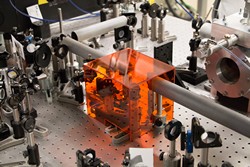Bright future for laser research in Europe
Aiming to create a place where laser research can reach new heights, the EU-funded project LASERLAB-EUROPE(opens in new window) (The integrated initiative of European laser research infrastructures III) brought together 33 organisations from 16 European countries. Together with associate partners, LASERLAB-EUROPE covered the majority of EU Member States. Twenty-two facilities provided access to their labs for research teams and laser-related communities and networks from Europe and other parts of the world. The transnational access programme provided scientists with the opportunity to use specialised large-scale installations for their research, paving the way to new discoveries. It also offered training to a new generation of scientists wishing to embark on a career in laser development and research. The consortium focused on a range of cutting-edge laser tools in four application areas that are important for retaining Europe's competitive position in these areas. These included use of lasers and photonics in biology and health, generation and acceleration of charged particles, and the development of radiation sources at the extremes. By promoting a culture of transnational cooperation, LASERLAB-EUROPE strengthened the capabilities of its virtual infrastructure to adapt to developments in laser science. The ultimate aim of LASERLAB-EUROPE was to overcome fragmentation of the landscape of national laser research laboratories in Europe. At the same time, it assisted EU Member States to create new infrastructures where these were lacking. The world's most powerful facility in lasers, the European Extreme Light Infrastructure (ELI) has been deployed in three sites in the Czech Republic, Hungary and Romania. Another big EU project, HIPER, investigated the possibility of creating energy from fusion, an abundant and secure energy source. Laser devices developed within the LASERLAB-EUROPE consortium are world-leading table-top devices for science, life sciences, medicine, engineering and environmental sciences.







